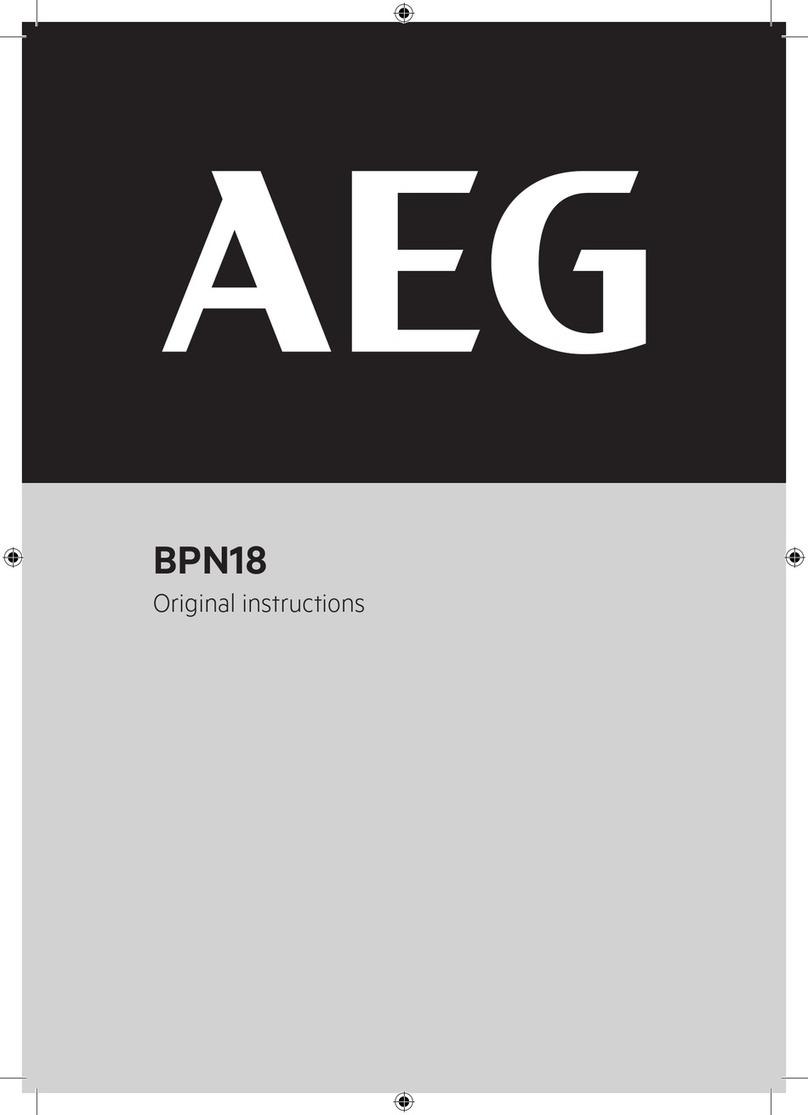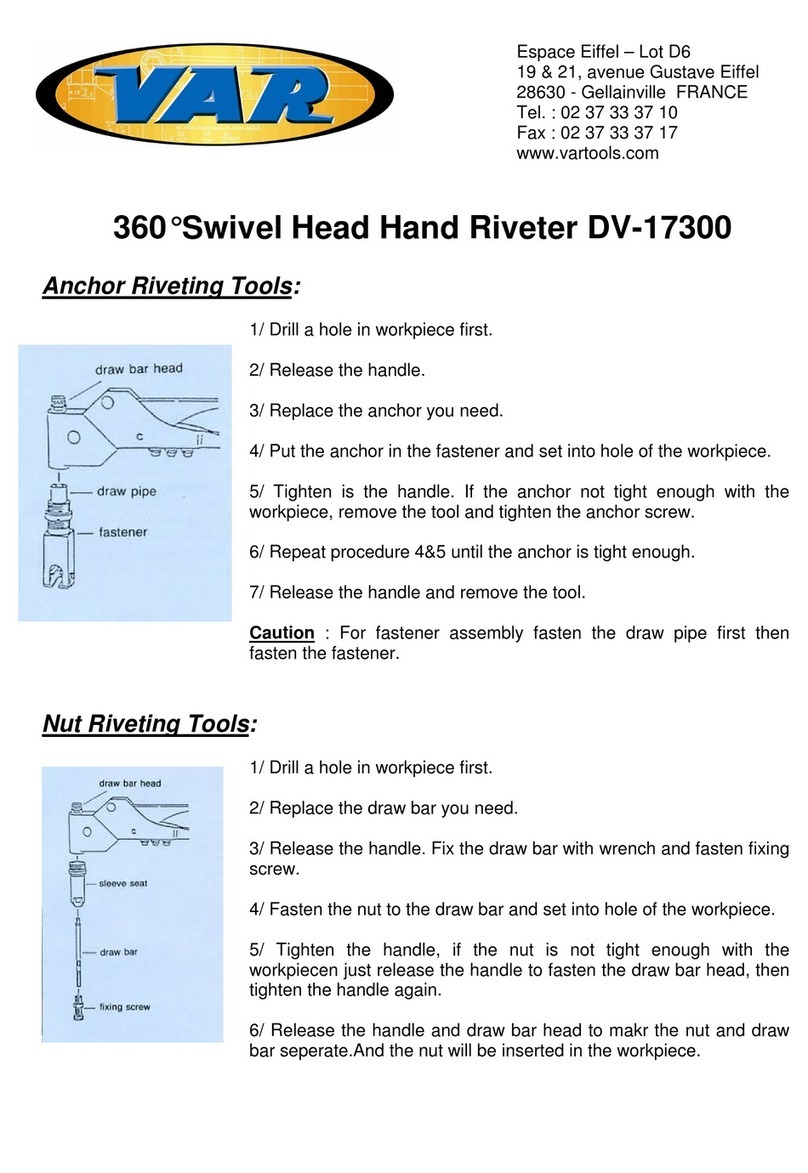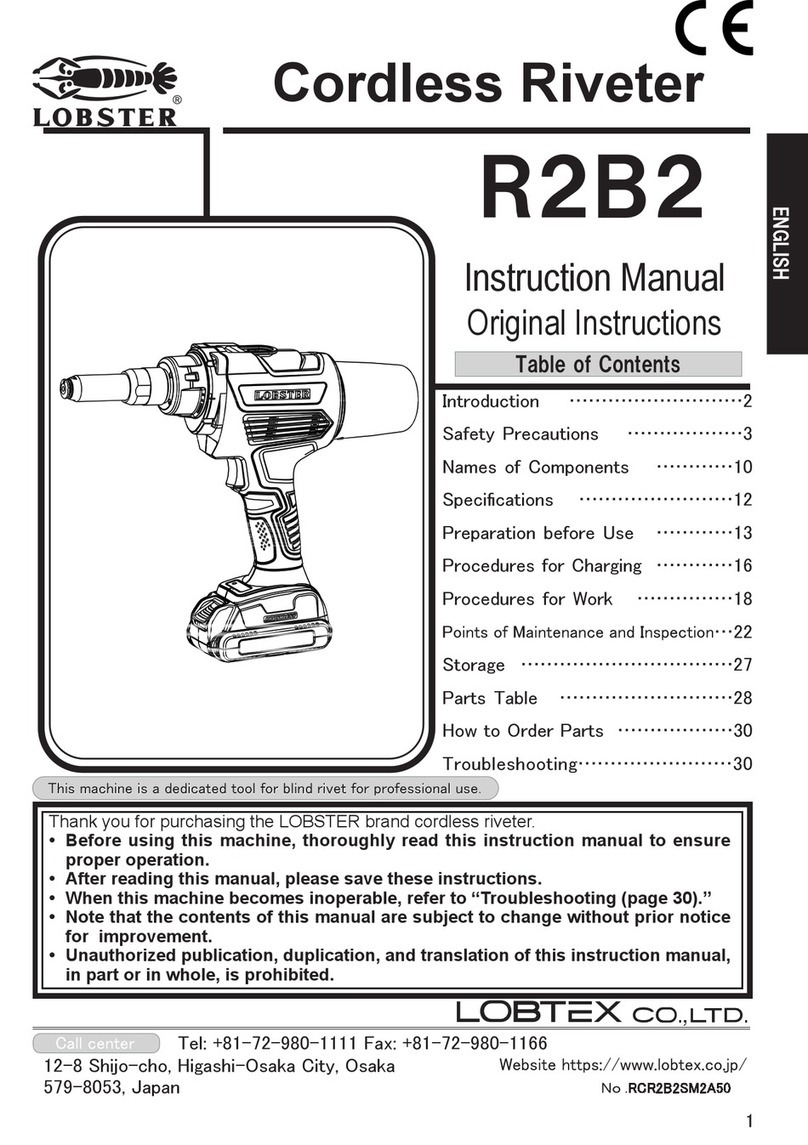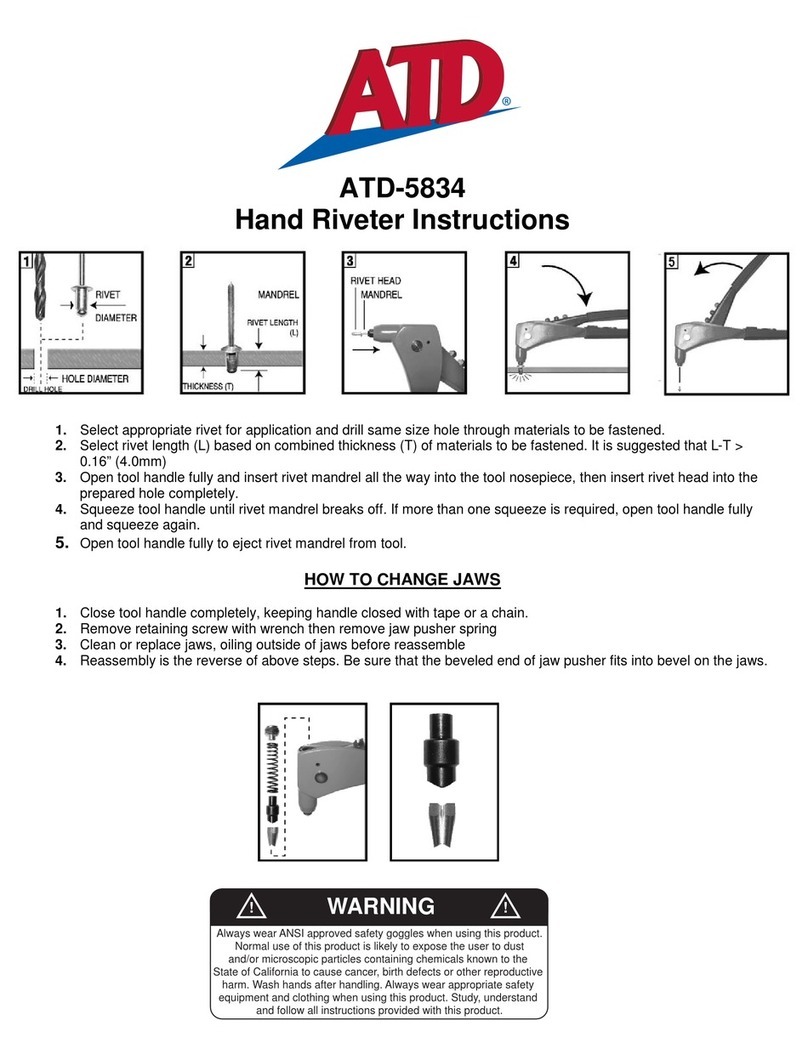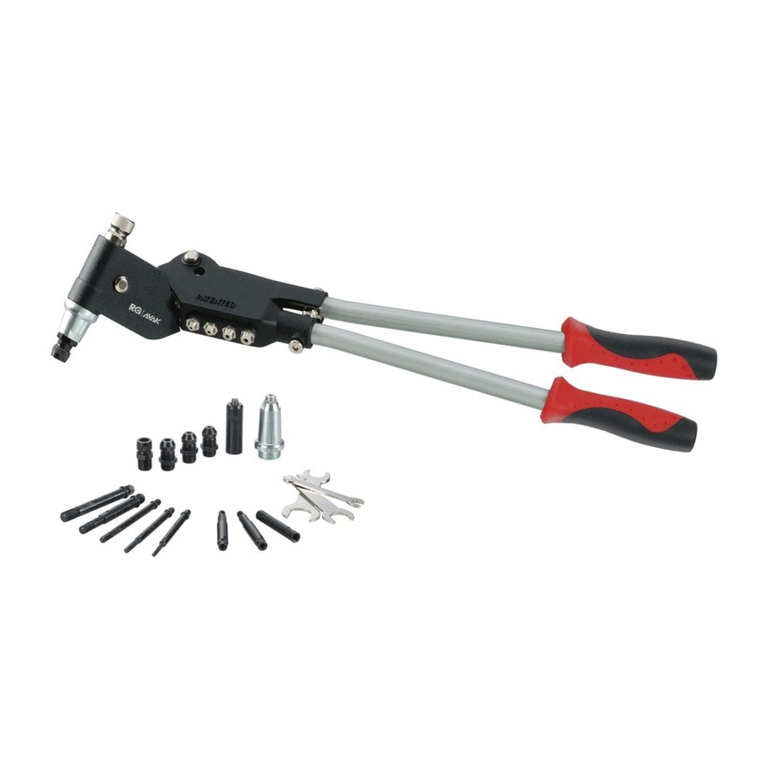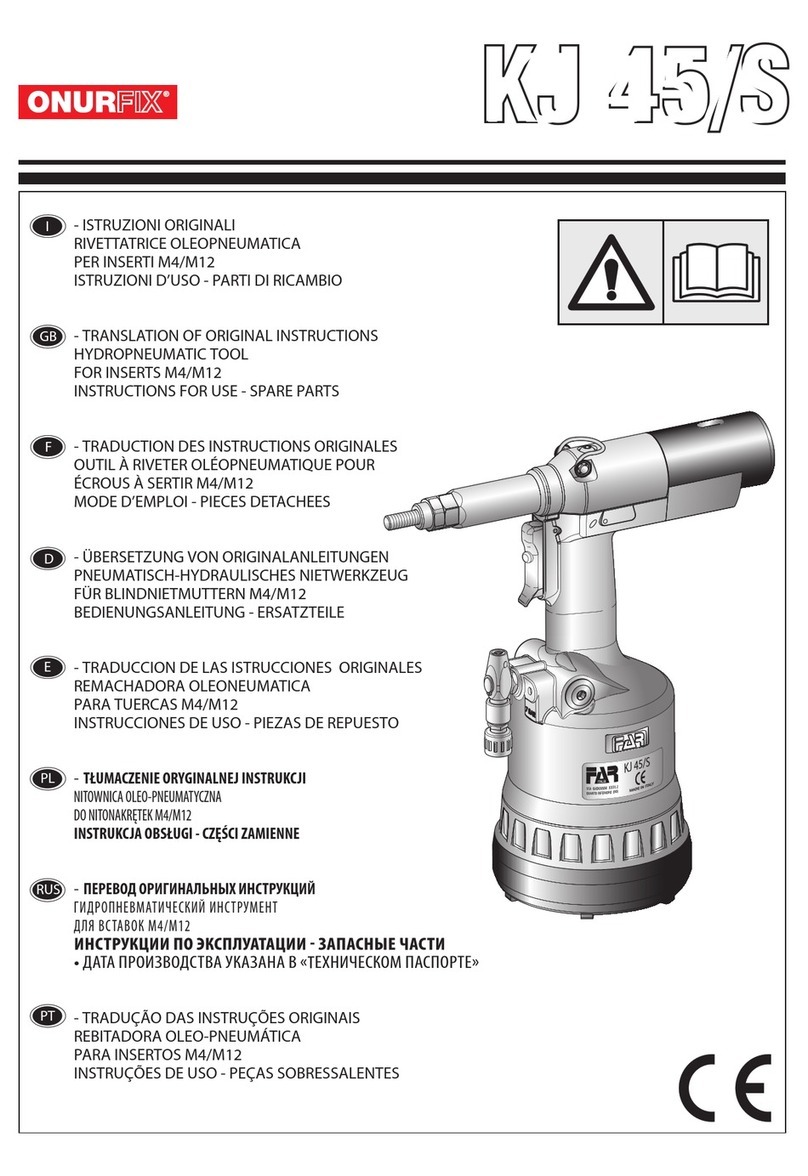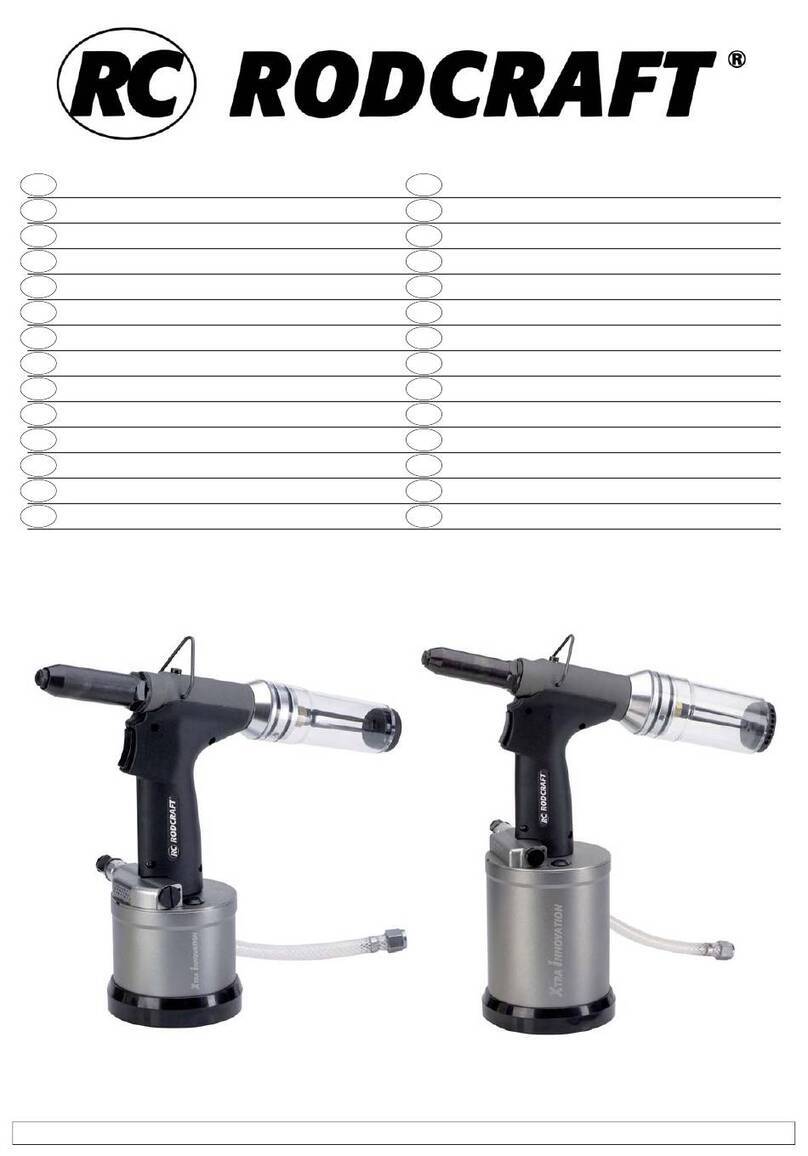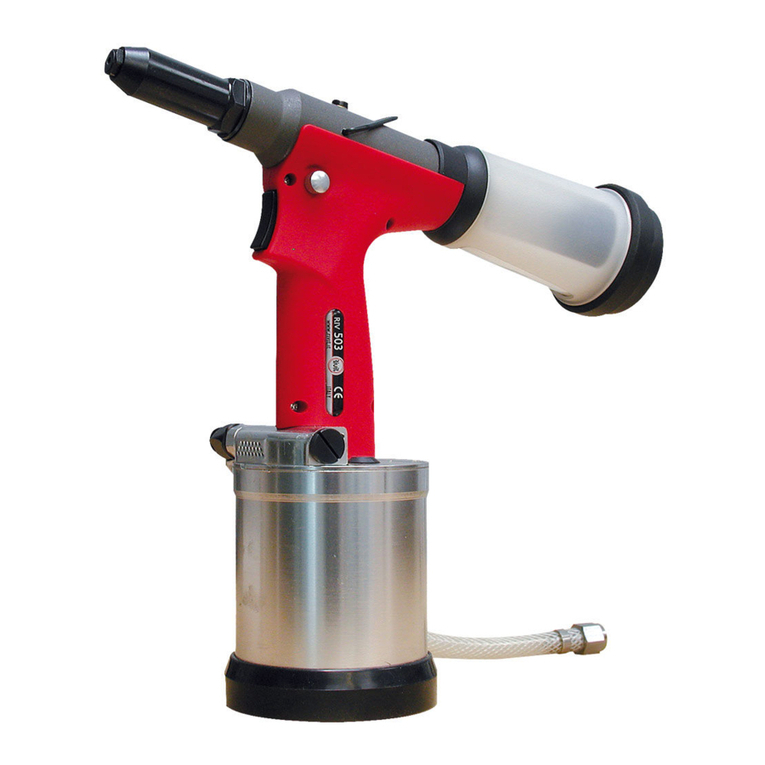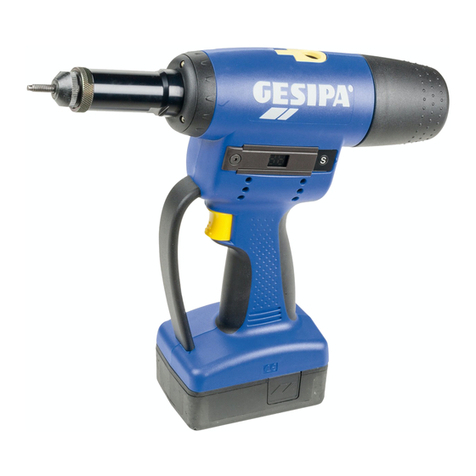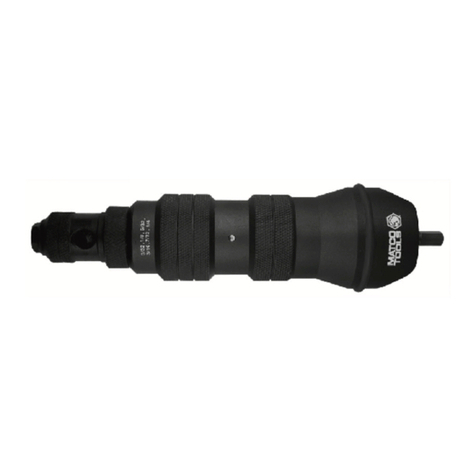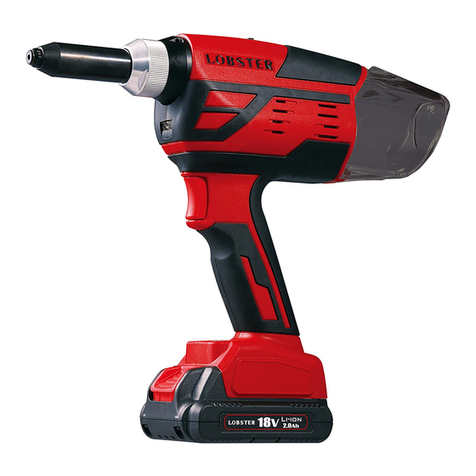Cherry Aerospace G902 User manual

Original Instructions G902
Cherry Lightweight Nut-Plate Riveter
1224 East Warner Ave,
Santa Ana, Ca 92705
Tel: 1-714-545-5511
Fax: 1-714-850-6093
www.cherryaerospace.com

THE G902 / G902-15
TABLE OF CONTENTS
Description ...........................................................................................................................................................................................1
Specifications for G902 / G902-15 ......................................................................................................................................................1
Safety Warnings ...................................................................................................................................................................................2
How to use G902 / G902-15 ...............................................................................................................................................................2
Maintenance and Repair .....................................................................................................................................................................2
Troubleshooting ...................................................................................................................................................................................2
Overhaul ...............................................................................................................................................................................................3
Air Valve ......................................................................................................................................................................................3
Handle Sub-Assembly ................................................................................................................................................................3
Pulling Heads .......................................................................................................................................................................................3
Installing Pulling Heads ..............................................................................................................................................................3
Cross Section Drawing Of G902 .........................................................................................................................................................4
Parts List for G902/G902-15 Riveters ................................................................................................................................................5
Exploded View of G902 / G902-15 .....................................................................................................................................................6
Declaration of Conformity ...................................................................................................................................................Back Cover
DESCRIPTION
The G902 feed-through/G902-15 side-eject all pneumatic lightweight tools are designed specifically for the most efficient
installation of blind rivets. Its durable, all metal housing makes this extremely robust tool ideal for use in rugged shop environments.
This tool utilizes a straight pulling head which can install 3/32", 1/8’’ pull through type Nut-Plate and 3/32" CherryLock “A” rivets.
Extensions are available for the G902 to allow the pulling heads to reach limited access areas.
See the section on pulling heads for the correct
pulling head part number.
SPECIFICATIONS FOR
G902 / G902-15
Cherry® Aerospace (CHERRY) policy is one of
continuous development. Specifications shown in
this document may be subject to change which
may be introduced after publication. For the latest
information always consult CHERRY®.
AIR PRESSURE: 90 PSI to 110 PSI
(6.2 bar to 7.6 bar)
STROKE: 3/4 Inch (19 mm)
PULLING FORCE: 550 Pounds (2.45 kN)
@ 90 PSI (6.2 bar)
CYCLE TIME: One Second approx.
WEIGHT 2 Pounds (.91 kg)
NOISE LEVEL 60 dB (A)
VIBRATION: less than 2.5 m/s2
AIR CONSUMPTION: 05 SCF/Cycle (1.42 L/cycle)
1

2
SAFETY WARNINGS
•Operating this tool with a damaged or missing stem deflector, or using the deflector as a handle, may result in severe personal
injury. Rotate the pin deflector until the aperture is facing away from the operator and other persons working in the vicinity.
•Approved eye protection should be worn when operating, repairing, or overhauling this tool.
•Do not use beyond the design intent.
•Do not use substitute components for repair. Any modification to the tool, pulling heads, accessories or any component supplied
by CHERRY®, or their representatives, shall be at the customer’s entire responsibility.
CHERRY® will be pleased to advise on any proposed modification.
•The tool must be maintained in a safe working condition at all times and examined at regular intervals for damage.
•Before disassembling the tool for repair, refer to the maintenance instructions. All repairs shall be undertaken only by personnel
trained by CHERRY®. Contact us with your training requirement.
•Always disconnect the air line from the tool inlet before attempting to service, adjust, fit or remove any accessory.
•Do not operate the tool when it is directed at any person.
•Make sure the vent holes do not become blocked or covered and that air line hoses are always in good condition.
•Do not operate the tool without the pulling head in place.
•All retaining rings, screwed end caps, air fittings, trigger valves and pulling heads should be attached securely and examined at
the end of each working shift
•Do not pull rivet in the air.
•The precautions to be used when using this tool must be explained by the customer to all operators. Any questions regarding
the correct operation of the tool and operator safety should be directed to CHERRY®.
•Do not pound on the rear of the tool head to force rivets into holes as this will damage the tool.
HOW TO USE THE G902 / G902-15
After selecting the proper pulling head and attaching it securely to the G902 or G902-15, connect the air line to the tool.
Insert the rivet stem into the pulling head until the head of the rivet is in contact with the pulling head nosepiece; this will ensure full
engagement between the jaws and the rivet stem and will prevent slippage.
MAINTENANCE AND REPAIR
The G902 or G902-15 has been manufactured to give maximum service with minimum care.
In order that this may be accomplished, the following recommendations should be followed:
1. Keep excessive moisture and dirt out of air supply to prevent wear of air valve, air cylinder and air piston.
2. Tool should be routinely inspected for damage or air leaks.
3. Periodically tighten the threaded connection between the rear piston sub-assembly (14) and the front piston (11)
(see instructions on page 3). A loose connection will result in an air leak and a loss of pulling force.
TROUBLESHOOTING (see Parts List, page 5)
1. Check for excessive air leakage from the air valve: If an O-ring on the valve stem (24) or on the valve sleeve (22) is worn or dam-
aged, air will leak through the bottom of the handle at the exhaust port or at the front of the trigger valve.
•If an O-ring (2) on valve sleeve (22) is worn or damaged, replace.
•If an O-ring (23) on valve stem (24) is worn or damaged, replace.
2. Check movement of the head piston rod (11). If it does not move freely or it is slow in operation:
•O-rings (19), (17), (16), (12), (9), (2), (6), (2) and O-ring (17) for G902-15 may be damaged and require replacement.
•Front and rear piston sub-assemblies (15 and 8) may be seized due to damaged parts and need replacement.
•The Ø.094" (2.388 mm) vent holes on the side of main cylinder may be blocked or damaged; clean as necessary.
3. Rivet stem sticks in the pulling head:
•Pulling head needs maintenance. Disassemble the pulling head; clean and replace worn parts as needed.
•Spent rivet stems are wedged inside the pistons. Disassemble the pulling head and remove jammed stems.

OVERHAUL
The disassembly and reassembly procedures can be accomplished by following the instructions below and the drawings on pages 4
& 6. Use extreme care during disassembly and reassembly not to mar, nick or burr any smooth surface that comes in contact with O-
rings. Before installing O-rings, be sure to apply an O-ring lubricant. It is recommended that a special assembly tool, which can be
ordered under part number 902-027, be used to overhaul this tool.
AIR VALVE
•Remove spring pin (21) by tapping it gently with a punch.
•Remove the valve sub-assembly by pressing on trigger (27) from behind with both thumbs using the handle (20) for leverage, or
pull and wiggle the trigger from the front.
•Remove the set screw (28) from the trigger (27).
•Disassemble the trigger (27) from valve stem (24).
•Remove retaining ring (26).
•Remove washer (25) from the counter bore of valve sleeve (22).
•Pull valve stem (24) out from valve sleeve (22).
HANDLE SUB-ASSEMBLY(see parts list)
•Always remove the complete pulling head from the tool before attempting to dissemble the head assembly. Remove front cap sub-
assembly (3) by unscrewing counterclockwise.
•Remove deflector pin (31) and deflector fitting (30) (G902-15 model does not use these components). Insert a 3/16 hex wrench
through the back of the tool into the rear piston sub-assembly (14).
•With hex wrench in place, locate the flats on the front piston rod (11). Use a 7/16 wrench, (for G902-15 model insert a pin in the
crossed drill hole of front piston rod (11)), to unscrew the front piston rod (11) by turning it counterclockwise.
Note: Do not use LoctiteTM when reassembling the front piston rod (11) to the rear piston sub-assembly (14); it would block the air
passage. Instead, torque to about 90 in-lbs.
•With the front piston rod (11) and front piston sub-assembly (3) out of the main housing, remove retaining ring (7) then push off
the front air piston sub-assembly (3) off of piston rod (11).
•Remove retaining ring (10) from the main handle bore.
•Use a 3/16 hex wrench to push out the rear piston sub-assembly (14) and bulk head (13).
•Use plug wrench 902-027 and locate the two holes on the rear plug (18) inside the main handle bore. Unscrew the rear plug by
turning the plug wrench counterclockwise.
G902 / G902-15 PULLING HEADS Pulling Heads are not
furnished with riveter and
must be ordered separately.
3
Riveter Model Pulling Head Rivet Rivet Diameters Maximum Grip
Nut-Plate 3/32, 2.5 mm, 3 mm -8 1
SPR®3/32 -8 1
H902-4NPR
H701B-456
H955 CherryLock
®
A 3/32 -8 1
Nut-Plate 3/32, 2.5 mm, 3 mm -9 1
SPR
®
3/32 -9 1
H9055-3 CherryLock
®
A 3/32 -9 1
H9015-4C Nut-Plate 1/8 -9 1
-8 1
H9015-3C
G902-15
H902-3NPR
Nut-Plate 1/8
G902 1Installed On First Stroke.
INSTALLING H902-3NPR PULLING HEAD ON RIVETER
1. Place jaws inside collet and place jaw follower in the collet
against jaws. Then screw drawbar adapter onto the collet
and tighten securely using wrenches on flats provided.
2. Insert spring into head piston. Screw collet sub-
assembly onto head piston and tighten securely
using wrenches on flats provided.
3. Thread tightly the proper nosepiece onto sleeve.
4. Thread sleeve into nose fitting, then tighten the jam nut to secure it against loosening.

CROSS SECTION OF G902
4

PARTS LIST FOR THE G902 (902-15) NUT-PLATE RIVETER ASSEMBLY
ITEM QTY.
1 1
2 6
34902-003** 1
5902-011** 1
6 1
7 1
8 1
9 2
10 1
11 1
12 1
13 1
14 15 902-006** 1
5902-011** 1
16 1
17 1
18 1
19 1
20 1
21 1
22 1
23 3
24 1
25 1
26 1
27 1
28 1
29 1
30 1
31 1
32 1
ITEM QTY.
1 1
2 5
34902-023** 1
5902-011** 1
11 1
17 2
G902 BILL OF MATERIALS (902-001)
PART NO. DESCRIPTION
704B2-2 FITTING, NOSE
P-701 O-RING
902-014 SUB-ASSEMBLY, FRONT CAP
CAP, FRONT
BUMPER, RUBBER
P-1400 O-RING
P-207 RING, RETAINING (INT. fl .500)
902-012 PISTON, FRONT
P-1401 O-RING
P-1398 RING, RETAINING (INT. fl 2.125)
902-004 ROD, PISTON
P-568 O-RING
902-005 HEAD, BULK
902-013 SUB-ASSEMBLY, REAR PISTON
PISTON, REAR
BUMPER, RUBBER
P-1399 O-RING
P-112 O-RING
902-007 PLUG, REAR
P-654 O-RING
902-002 HANDLE, MACHINED
P-1396 PIN SPRING, fl 1/8 X 1 LG
902-010 SLEEVE, VALVE
P-1402 O-RING
902-009 STEM, VALVE
P-1403 WASHER, RETAINING
P-600 RING, RETAINING (INT. fl .437)
902-016 TRIGGER, MACHINED
P-1397 SET-SCREW
P-880 RING, RETAINING (NON-STANDARD)
703A13 FITTING, DEFLECTOR
530A16 DEFLECTOR, PIN
902-024 SUB-ASSEMBLY, FRONT CAP
670A20* BAG, MANDREL COLLECTOR
* SOLD SEPARATELY.
** NOT SOLD SEPARATELY.
CAP, FRONT
BUMPER, RUBBER
G902-15 BILL OF MATERIALS (902-020) - DIFFERENCE FROM G902
PART NO. DESCRIPTION
902-022 FITTING, NOSE
P-701 O-RING
NOTE: ITEMS 29 TO 32 (P-880, 703A13, 530A16 AND 670A20) ARE NOT USED IN G902-
15 TOOL.
P-112 O-RING
902-021 ROD, PISTON
5

EXPLODED VIEW OF G902 / G902-15
6

Declaration of Conformity
We, Cherry® Aerospace, 1224 E. Warner Ave., Santa Ana, CA 92705
declare under our sole responsibility that the product
type G902
1224 East Warner Ave,
Santa Ana, Ca 92705
Tel: 1-714-545-5511
Serial No.-
to which this declaration relates is in conformity with the following standards
EN292 part 1 and part 2
ISO 8662 Part 1
ISO 3744
following the provisions of the Machine Directive 89/392/EEC
(as amended by Directive 91/368/EEC) and 93/68/EEC
Santa Ana, CA -
date of issue
Original certification and signatures on file
Fax: 1-714-850-6093
www.cherryaerospace.com
©
2007 Cherry Aerospace
Supplier’s Federal Identification Code: 11815
Seller warrants the goods conform to applicable specifications and drawings and will be manufactured and inspected according to generally accepted practices of
companies manufacturing industrial or aerospace fasteners. In the event of any breach of the foregoing warranty, Buyer’s sole remedy shall be to return defective
goods (after receiving authorization from Seller) for replacement or refund of the purchase price, at the Seller’s option. Seller agrees to any freight costs in
connection with the return of any defective goods, but any costs relating to removal of the defective or nonconforming goods or installation of replacement goods
shall be Buyer’s responsibility. SELLER’S WARRANTY DOES NOT APPLY WHEN ANY PHYSICAL OR CHEMICAL CHANGE IN THE FORM OF THE
PRODUCT IS MADE BY BUYER.
THE FOREGOING EXPRESS WARRANTY AND REMEDY ARE EXCLUSIVE AND ARE IN LIEU OF ALL OTHER WARRANTIES AND REMEDIES;
ANY IMPLIED WARRANTY AS TO QUALITY, FITNESS FOR PURPOSE, OR MERCHANTABILITY IS HEREBY SPECIFICALLY DISCLAIMED AND
EXCLUDED BY SELLER. THIS WARRANTY IS VOID IF SELLER IS NOT NOTIFIED IN WRITING OF ANY REJECTION OF THE GOODS WITHIN ONE
(1) YEAR AFTER INITIAL USE BY BUYER OF ANY POWER RIVETER OR NINETY (90) DAYS AFTER INITIAL USE OF ANY OTHER PRODUCT.
WARRANTY
Seller shall not be liable under any circumstances for incidental, special or consequential damages arising in whole or in part from any breach by Seller, AND SUCH
INCIDENTAL
,
SPECIAL
,
OR CONSE
Q
UENTIAL DAMAGES ARE HEREBY EXPRESSLY EXCLUDED.
For more information
p
lease contact our Technical Services De
p
artment at Tel. 714-850-6022
LOCTITE
®
is a registered trademark of Henkel Corporation
DEXRON®is a registered trademark of GM corporation.
PARKER®is a trademark of Parker Hannifin Corporation
LUBRRIPLATE®is a trademark of Fiske Brothers Refining Co.
TM-G902
Rev.: B
DCR# 08-0240
Date: 06/13/08
This manual suits for next models
1
Table of contents
Other Cherry Aerospace Rivet Tools manuals
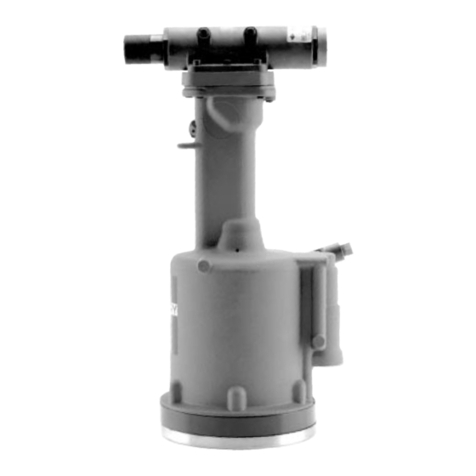
Cherry Aerospace
Cherry Aerospace G-689 User manual
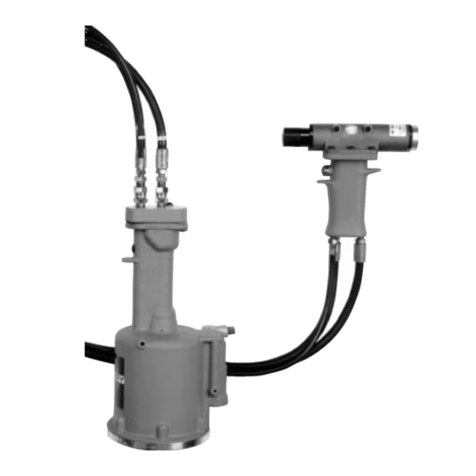
Cherry Aerospace
Cherry Aerospace CherryLOCK G685B-S User manual
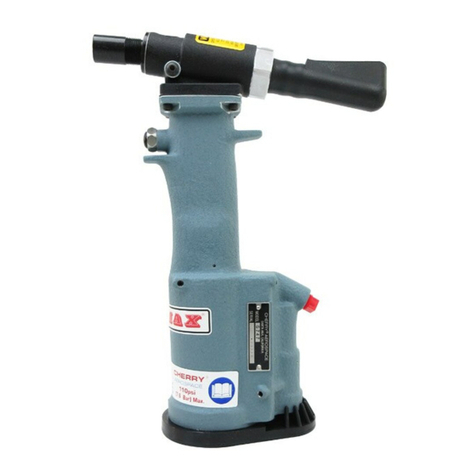
Cherry Aerospace
Cherry Aerospace CherryMAX G747 User manual
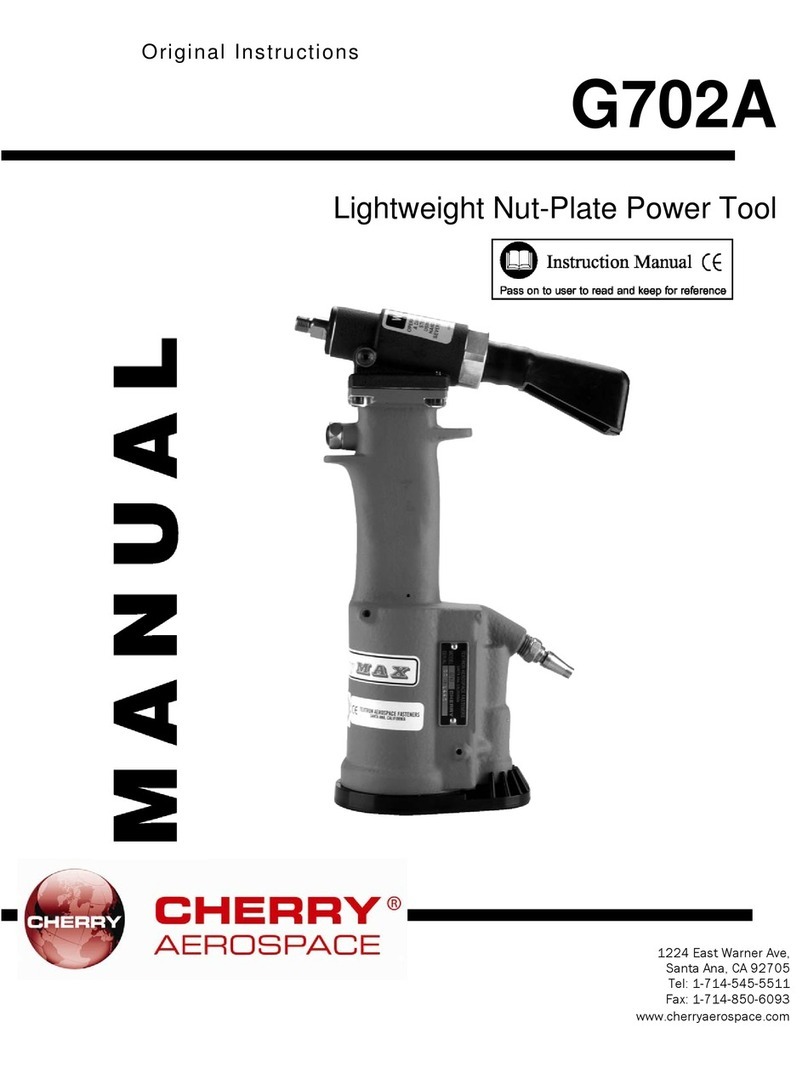
Cherry Aerospace
Cherry Aerospace G702A User manual

Cherry Aerospace
Cherry Aerospace G715A User manual
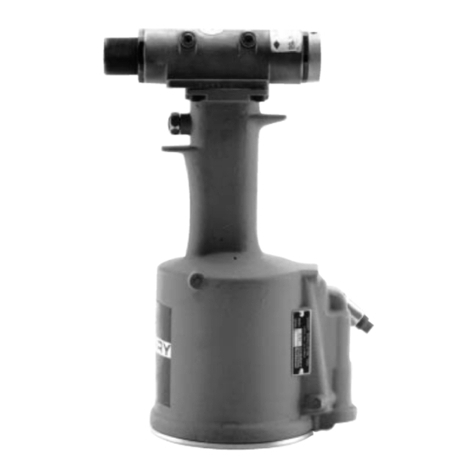
Cherry Aerospace
Cherry Aerospace G700 User manual

Cherry Aerospace
Cherry Aerospace CHERRYMAX G749A User manual
